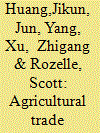|
|
|
Sort Order |
|
|
|
Items / Page
|
|
|
|
|
|
|
| Srl | Item |
| 1 |
ID:
078034


|
|
|
|
|
| Publication |
2007.
|
| Summary/Abstract |
The overall goal of this paper is to examine the impacts of trade liberalization on China's agriculture, in general, and poverty, in particular. The impacts on agriculture are analyzed by commodity and by region. Because different farmers (especially those in different income brackets) produce diverse sets of commodities, the main part of our paper analyzes the effects on households and their implications for the poverty through the simulation of household production and consumption changes in response to the trade-induced market prices changes on a disaggregated (by province), household-level basis. The results of our analysis lead to the conclusion that, unlike fears expressed in the popular press and by some scholars, the positive impacts of trade liberalization are actually greater than the negative ones. Although other effects on the rural economy from trade liberalization of other subsectors (such as textiles) may be equally large or even larger, this study's focus on the agricultural sector shows that there will be an impact from agricultural trade liberalization and that the net impact is positive for the average farm household in China. However, policymakers still need to be concerned. Not all households and not all commodities will be treated equally. Our findings show that poorer households, especially those in the provinces in the western parts of China, will be hurt. The main reason is that the farmers in Western China are currently producing commodities that are receiving positive rates of protection, rates of protection that will fall with additional trade liberalization. Hence, if policy makers want to minimize the impacts, there needs to be an effort to minimize the effect on these households either by direct assistance or by eliminating constraints that are keeping households from becoming more efficient by shifting their production more towards those commodities that will benefit from trade liberalization
|
|
|
|
|
|
|
|
|
|
|
|
|
|
|
|
| 2 |
ID:
078033


|
|
|
|
|
| Publication |
2007.
|
| Summary/Abstract |
The emergence of China has intensified the international segmentation of production processes within Asia, but has not created an autonomous engine for the region's trade, as Asia still depends on outside markets for its final goods exports. The reorganisation of production has weakened the position of the advanced economies in Asia's trade, but up to now has not severely affected the position of the emerging Asian economies. However, the deterioration of China's terms of trade raises the question of the sustainability of its recent growth strategy
|
|
|
|
|
|
|
|
|
|
|
|
|
|
|
|
| 3 |
ID:
078035


|
|
|
|
|
| Publication |
2007.
|
| Summary/Abstract |
We analyze empirically whether the emergence of China as a large recipient of FDI has affected the amount of FDI received by Latin American countries. Allowing for the structural break related to China's WTO accession, we found a significant negative impact of Chinese inward FDI on that of Mexico until 2001 and on that of Colombia after that date. The rest of Latin American countries do not seem to be affected by Chinese inward FDI. For the region as a whole, there is no significant Chinese effect on Latin America's FDI
|
|
|
|
|
|
|
|
|
|
|
|
|
|
|
|
| 4 |
ID:
078039


|
|
|
|
|
| Publication |
2007.
|
| Summary/Abstract |
In the presence of de jure capital account inconvertibility, but in spite of high trade openness of China, existing empirical work, using daily data, has not found any evidence of international financial integration of its A-share market. In this paper we shed new light on this issue, examining a long sample of active trading, over 1992-2005, within the framework of a regime-switching error correction model, with a major focus on the role of temporal aggregation. With end-of-week closing prices we do not find any long run relationship between the Shanghai market and either the New York or the Hong Kong market, thus replicating previous findings. However, with weekly-averaged indices, up to late 1996, the Shanghai index was cointegrated with the S&P 500. Subsequently, this relationship broke down and a long run relationship with the Hang Seng index gradually arose. Information flows, as well as the prospects of de jure financial opening, and the growing awareness of valuation concepts among Chinese domestic investors, in the presence of identical fundamentals (multiple listing of Mainland firms), help explain the evidence of long run financial integration in spite of capital controls
|
|
|
|
|
|
|
|
|
|
|
|
|
|
|
|
| 5 |
ID:
078037


|
|
|
|
|
| Publication |
2007.
|
| Summary/Abstract |
This paper assesses the progress of China's transition towards a market economy by examining the structure of ownership, productivity, and profitability, as well as the concentration of production across firms, industries, and regions. It does this by analyzing a database of firm microdata of the quarter of a million industrial companies in operation during the 1998-2003 period. Results show that the private sector now accounts for more than half of industrial output, compared with barely more than a quarter of it in 1998, and operates much more efficiently than the public sector. Higher productivity has fed through to improved profitability, motivating greater regional specialization of production. These changes are consistent with what would be expected in a market-based economy and suggest that reforms are making rapid progress
|
|
|
|
|
|
|
|
|
|
|
|
|
|
|
|
| 6 |
ID:
078036


|
|
|
|
|
| Publication |
2007.
|
| Summary/Abstract |
Empirical models are developed in this paper to quantitatively analyze households' participation in decisions on hiring labor and supplying labor off the farm, hired labor demand and off-farm labor supply of rural Chinese households. Econometric estimates use micro-level data from Zhejiang province over the period 1995-2002. The main results suggest that the decisions to hire labor and participate off the farm are made jointly and are positively correlated. A household's labor demand decreases with increasing wages for hired labor, whereas the effect of the wages of off-farm workers on a household's labor supply differs significantly depending on the household's kind of labor market participation. The results also indicate that the accumulation of productive assets, the development of livestock production and agricultural prices have increasing effects on labor demand but reducing effects on a household's off-farm labor supply. Land market integration enhances participation significantly but has no significant impact on time allocation. Finally, the results suggest non-separability between hired labor demand and household characteristics, indicating the rural labor market in Zhejiang province is still functioning imperfectly
|
|
|
|
|
|
|
|
|
|
|
|
|
|
|
|
| 7 |
ID:
078038


|
|
|
|
|
| Publication |
2007.
|
| Summary/Abstract |
The impacts of the real exchange rate on employment and its channels are investigated. A real appreciation, (1) by switching factors from workers to imported inputs (technological channel), (2) by decreasing exports (export volume channel), (3) by exerting pressure on efficiency improvement (efficiency channel), exerts an effect on employment. Using the panel data of the 29 Chinese provinces for the period 1993-2002, the econometric results show statistically significant negative effects of the real appreciation of the renminbi on manufacturing employment. The three channels are statistically significant, the technological channel being the most important
|
|
|
|
|
|
|
|
|
|
|
|
|
|
|
|
|
|
|
|
|